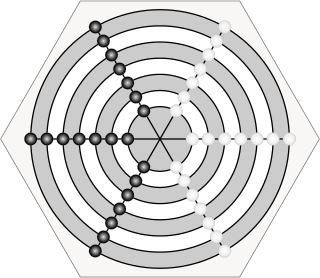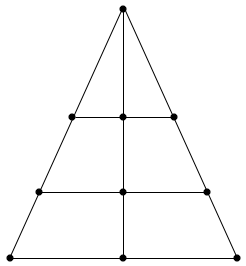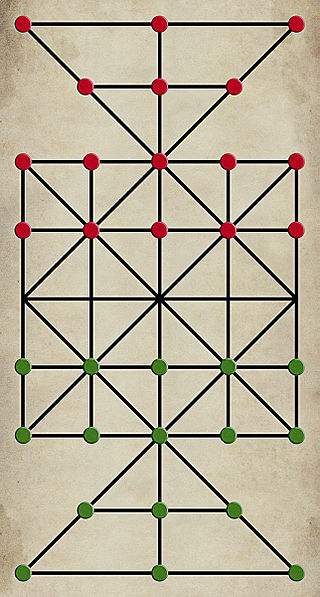Permainan-Tabal is an Indonesian two-player abstract strategy board game. The game is sometimes referred to as a cross between alquerque and draughts. It is essentially draughts played on an expanded alquerque board. It is especially similar to draughts in that the moves of the pieces are strictly forward and sideways until they are promoted to kings by reaching the other player's first rank. The game is also referred to as dama.
Rimau-rimau is a two-player abstract strategy board game that belongs to the hunt game family. This family includes games like bagh-chal, main tapal empat, aadu puli attam, catch the hare, sua ghin gnua, the fox games, buga-shadara, and many more. Rimau-rimau is the plural of rimau which is an abbreviation of the word harimau, meaning 'tiger' in the Malay language. Therefore, rimau-rimau means 'tigers'. The several hunters attempting to surround and immobilize the tigers are called orang-orang, which is the plural of orang, meaning 'man'. Therefore, orang-orang means 'men' and there are twenty-two or twenty-four of them, depending on which version of the game is played. The game originates from Malaysia.
Main tapal empat is a two-player abstract strategy board game from Malaysia. It is a hunt game, and specifically a tiger hunt game since it uses an Alquerque board. The tigers can move as many spaces in a straight line as a clear path allows. Most hunt games have tigers, leopards, or foxes moving only one space at a time. In effect, the tigers in this game have the movement capability of the queen in chess.
Egara-guti is a two-player abstract strategy game from India, specifically from Central Provinces, and it was described by H.J.R. Murray in A History of Board-Games Other Than Chess (1952). The game is related to Draughts and even more so to Alquerque. Pieces are captured by leaping over them. Egara-Guti consists of a Lau kata kati board, but with the addition of two lines connecting the two triangles and running through them. Egara-guti belongs to a specific category of games called Indian War-games; some other games in this category are Lau kata kati, Dash-guti, Pretwa, Gol-skuish. All Indian War-games have one important thing in common, and that is that all the pieces are laid out on the grid patterned board in the beginning, with only one vacant point in the center. This forces the first move to be played on the central point, and captured by the other player's piece.

Pretwa is a two-player abstract strategy game from Bihar, India, and it was described by H.J.R. Murray in A History of Board-Games Other Than Chess (1952). The game is related to draughts and Alquerque as pieces are captured by leaping over them. The board is composed of three concentric circles divided by three diameters. Pretwa belongs to a category of games called Indian war games, which also includes the games Lau kata kati, Dash-guti, Egara-guti, Gol-skuish. All Indian war games have one important thing in common, and that is that all the pieces are laid out on the board at every intersection point, with the exception of the central point. This forces the first move to be played on the central point, and captured by the other player's piece.

Gol-skuish is a two-player abstract strategy game from India, specifically from Central Provinces, and it was described by H.J.R. Murray in A History of Board-Games Other Than Chess (1952). The game belongs to the draughts and Alquerque family as pieces are captured by leaping over them. The board is composed of seven concentric circles divided by three diameters. Gol-skuish belongs to a specific category of games called Indian War-games which include Lau kata kati, Dash-guti, Egara-guti, and Pretwa. At the beginning of every Indian War-game all the pieces are laid out on the board at every intersection point, with the exception of the central point. This forces the first move of the game to be played on the central point, and captured by the second player's piece.

Peralikatuma is a two-player abstract strategy board game from Sri Lanka. It is a game related to draughts (checkers) and alquerque as players hop over one another's pieces when capturing them. The game was documented by Henry Parker in Ancient Ceylon: An Account of the Aborigines and of Part of the Early Civilisation (1909) with the name perali kotuwa or the war enclosure. Parker mentions that it is also played in India. It closely resembles another game from Sri Lanka called Kotu Ellima. The two games use the same board which consist of a standard alquerque board but with four triangular boards attach to its four sides. The only difference between the two games is in the number of pieces. In peralikatuma, each player has 23 pieces. In Kotu Ellima, each player has 24 pieces.

Conspirateurs is a two- or four-player strategy board game said to have been invented in 18th-century France. Robert Charles Bell believes the game to date from after 1789, following the French Revolutionary Wars, "a period of feverish political activity with factions conspiring against each other".
Rimau is a two-player abstract strategy board game from Malaysia. It is a hunt game, and specifically a tiger hunt game since it uses an expanded alquerque board. One tiger is being hunted by 24 men. The tiger attempts to eat the men, and the men attempt to trap the tiger. Unique to rimau, the tiger can capture a line of men in a single leap. There must be an odd number of men in the line, and they must be adjacent to one another. In most hunt games, the tiger, leopard, or fox is only able to capture one prey in a leap.

Len choa is a two-player abstract strategy game from southern Thailand, first documented by Captain James Low in 1839. It is a Leopard hunt game. One tiger is going up against six leopards. The leopards attempt to surround and trap the tiger while the tiger attempts to capture enough of them so that the leopards can not immobilize the tiger. It is unknown how old the game is, and it is only known from the periodical Asiatic Researches; or, Transactions of the Society, Instituted in Bengal, For Inquiring into The History, The Antiquities, The Arts and Sciences, and Literature of Asian, Second Part of the Twentieth Volume and specifically in chapter X On Siamese Literature (1839) in which Low authored. It is very similar to a game played in Sri Lanka called Hat diviyan keliya.

Hat diviyan keliya is a two-player abstract strategy game from Sri Lanka. It is a Leopard hunt game. One tiger is going up against seven leopards. The leopards attempt to surround and trap the tiger while the tiger attempts to capture enough of them so that the leopards can not trap it.

Demala diviyan keliya or Koti Sellama is a two-player abstract strategy board game from Sri Lanka, formerly known as Ceylon. It is a hunt game, and since it uses a triangle board, Demala diviyan keliya is specifically a leopard hunt game. Three leopards are going up against fifteen dogs. The dogs attempt to surround and trap the leopards while the leopards attempt to capture enough of them in order to foil their objective. It is unknown how old the game is, but the game was described by H. Parker in his 1909 book Ancient Ceylon: An Account of the Aborigines and of Part of the Early Civilisation. The game is also known as the Tamil leopards' game. The game is well known in Southern India, and its Hindustani name is Rafāya.
Tiger game played with forty, translation of meurimueng-rimueng peuet ploh, is a two-player abstract strategy board game from Sumatra, Indonesia. The last part of the name, ploh, is sometimes spelled "plo". It is specifically played by the Acehnese. The game was described in The Achehnese by Hurgronje, O'Sullivan, and Wilkinson in 1906 and described on page 204.

Leopard hunt games or simply leopard games are a group of abstract strategy games of Southeast Asian origin, similar in spirit to European fox games. However, they are believed to have arisen independently. The games are usually played on a triangular board with three horizontal parallel lines intersecting the other two sides of the triangle and a vertical bisector. Though a number of variants exist, the basic principle of the game sees one player with a single piece and the other playing six or seven pieces. Players move pieces in turn along the board's lines. The objective for the hunter is to capture the opponents pieces by "jumping" over them as in checkers while the hunted seeks to corner the hunter so that it has no possible move.

Sixteen soldiers is a two-player abstract strategy board game from Sri Lanka. It also comes from India under the name cows and leopards. A variant of this game is also popular in Bangladesh, where it is known as sholo guti. One way it is played, is by drawing the court of the game on the ground and using stones as pawns.
Kotu Ellima is a two-player abstract strategy board game from Sri Lanka played by the Sinhalese people. The game was documented by Henry Parker in Ancient Ceylon: An Account of the Aborigines and of Part of the Early Civilisation (1909); the game was printed as "Kotu Ellima" which is actually a misspelling because his source for the game was Leopold Ludovici's Journal of the Ceylon Branch of the Royal Asiatic Society (1873), and specifically in the chapter entitled "The Sports and Games of the Singhalese", and Ludovici wrote the name of the game as Kotu Ellime or Taking of the Castles. The game is similar to draughts (checkers) and Alquerque as players hop over one another's pieces to capture them; it is more similar to Alquerque between the two since it uses a standard Alquerque board. However, unlike draughts and standard Alquerque, the game is played on an expanded Alquerque board consisting of four triangular boards attached to the four sides of a standard Alquerque board. It closely resembles peralikatuma and sixteen soldiers which are also played in Sri Lanka and other parts of the Indian subcontinent with the only difference being the number of pieces. In sixteen soldiers, each player has 16 pieces hence the name of the game. In peralikatuma, each player has 23 pieces. In Kotu Ellima, each player has 24 pieces, and at the beginning of the game the whole board is covered with them except the central point reminiscent of standard alquerque.
Awithlaknannai Mosona is a two-player strategy board game from the Zuni Native American Indian tribe of New Mexico, United States. It is unknown how old the game is. The game was described by Stewart Culin in his book "Games of the North American Indians Volume 2: Games of Skill" (1907). In this book, it was named Awithlaknan Mosona. Awithlaknannai Mosona resembles another Zuni board game called Kolowis Awithlaknannai with few minor differences. The former having a smaller board, and depending upon the variant, it also has less lines joining the intersection points. The rules are the same. Awithlaknannai Mosona belongs to the draughts and alquerque family of games as pieces hop over one another when capturing. It is actually more related to Alquerque, since the board is made up of intersection points and lines connecting them. It is thought that the Spanish had brought Alquerque to the American Southwest, and Awithlaknannai Mosona may have been an evolution from Alquerque. However, in Stewart Culin's 1907 book, the Zunis claim that they had adopted a hunt game from Mexico similar to catch the hare and the fox games of Europe, and transformed it into Awithlaknannai Mosona. In these games, one player has more pieces over the other, however, the other player's piece has more powers. The Zuni's equalized the numbers of pieces and their powers, and also may have transformed the board making its length far exceed its width. Diagonal lines also replaced orthogonal lines altogether. However, the hunt game from Mexico may have used an alquerque board even though the game mechanics of their new game, Awithlaknannai Mosona, were completely different.
Tiger and buffaloes is a two-player abstract strategy board game from Myanmar. It belongs to the hunt game family. The board is a 4x4 square grid, where pieces are placed on the intersection points and move along the lines. It is one of the smallest hunt games. Three tigers are going up against eleven buffaloes. The tigers attempt to capture as many of the buffaloes by the short leap as in draughts or alquerque. The buffaloes attempt to hem in the tigers.
Terhüchü is a two-player abstract strategy board game from Nagaland in Northeast India and is played by the Angami Naga ethnic group.








